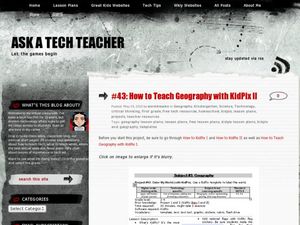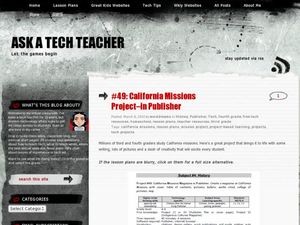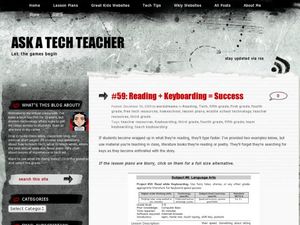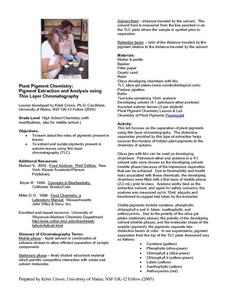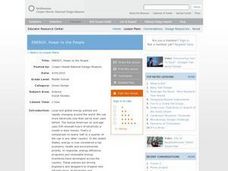Curated OER
How to Teach Geography with KidPix II
Students use the computer program KidPix II to color a map of the world. In this world map lesson plan, students fill in different colors for different continents that are told to them on the program KidPix II.
Curated OER
California Missions Project-Using Publisher
Students create a California Missions magazine that includes a Table of Contents, pictures, and websites. In this culture and history lesson, students research missions and write and create a magazine article about it.
Curated OER
History Trifold in Publisher
Students create a timeline of events happening around the world. In this timeline lesson plan, students use Microsoft Publisher to create a timeline of events happening around the world as they live their lives presently.
Curated OER
Indegenous Cultures Magazine in Publisher
Fourth graders use Publisher to create their own magazine. In this online magazine lesson, 4th graders follow the instructions to create a magazine using text, pictures, and colors within the Publisher system.
Curated OER
Reading + Keyboarding= Success
Students practice their keyboarding skills. In this typing lesson, students use interesting stories to practice their skills. They practice throughout the semester and then monitor their improvement.
Curated OER
How to keep a timecard in Excel
Students fill out a timecard of family activities in Microsoft Excel. In this Excel lesson plan, students use the program to fill in times they do various activities with their families.
Curated OER
Tessellations in Excel
Students complete an Excel project on tessellations. In this technology and math lesson, students discuss tessellations and their occurrences in nature. Students use the Excel computer program to create tessellations.
Curated OER
Animal Characteristics
Students create a graphic organizer to study animal characteristics. For this animal characteristics lesson plan, students use a program in Microsoft Word to create a brainstorm about different animal characteristics.
Curated OER
Don't Print Homework-Email It!
Students practice emailing their homework. In this technology lesson plan, students review how to type an email address correctly and how to send it to the correct address. Students complete their homework and send it to their teacher.
Curated OER
Understanding the Epidemiologic Triangle through Infectious Disease
Students examine the epidemiologic triangle. In this disease lesson, students discuss infectious disease as they study how they spread and discover their families' experiences with them. Students research Internet sites to complete...
Curated OER
Plant Pigment Chemistry
Students discover the roles of pigments present in leaves. They extract and isolate pigments present in autumn leaves using a thin layer chromatography. Very nice lesson and lab!
Curated OER
Energy: Power to the People
Students explore the concept of renewable energy. In this green design lesson, students research local energy issues facing their community and create policies to address the issues.
Curated OER
"I Have a Dream" Shown in Pictures
Students demonstrate their understanding of Dr. King's dreams by drawing a picture representing one of them. For this Dr. King activity lesson, students read the speech "I Have a Dream" and discuss the vocabulary. Students select one of...
Curated OER
Life in the Arctic
Students create a model of an arctic animal. In this animal adaptation lesson, students research an arctic animal, create a 3-D model of their animal, and explain the physical characteristics animals in the arctic need to survive.
Curated OER
Progressive City Planners
Students plan cities. In this environmental racism instructional activity, students design imaginary cities taking into consideration the amenities and environmental hazards that exist. Students discuss city planning challenges.
Curated OER
Fashion Forward, Fashion Functional
Middle schoolers consider the implications of waste. In this waste streams lesson, students learn what waste streams are and identify their impact on the environment. Middle schoolers also recycle waste materials to create functional...
Curated OER
Tales From The Tummy
Learners use creative writing in order to review the digestive system and other various parts of the human body. They write a creative story about a hamburger and the journey it takes during digestion. The lesson includes key words that...
Curated OER
Materials, Let's Do the Life Cycle
Students examine environmental and social impacts of products that consumers buy. In this environmental stewardship lesson, students play a game that requires them to consider real costs of products. Students consider the environmental...
Curated OER
Materials: Hidden Costs, Mapping the Source and Cost of Raw Materials.
Students map connections among raw materials. In this environmental stewardship instructional activity, students design strategies to minimize the use of raw materials and discuss how to use more sustainable materials.
Curated OER
Yes, Thank You!
Learners explore public signage and create positive message signs. In this social interactions lesson, students explore their own neighborhoods for examples of positive, negative, and neutral signage and use this knowledge to create...
Curated OER
The Allergy Chronicles
Students discuss their preconceived ideas about allergic reactions. They assume the role of health writers preparing a special section for the school newspaper on allergies. They research information about allergies and discuss their...
Curated OER
Epidemiology 1: What's My Hypothesis?
Students demonstrate how descriptive epidemiological clues can be used to make educated guesses as to what might be the cause of a disease. They utilize handouts imbedded in this lesson plan.
Curated OER
Beetle Infestation
Seventh graders investigate the consequences of insect infestation of trees over a period of time. this lesson plan can tailgate a segment on the life cycle of beetles and lead off a environmental lesson plan.
Curated OER
The Human Body: Focusing on Respiratory and Circulatory Systems
Students study the components and functions of the respiratory and circulatory systems. They take blood pressure using a stethoscope and investigate ways to maintain a healthy respiratory system.


